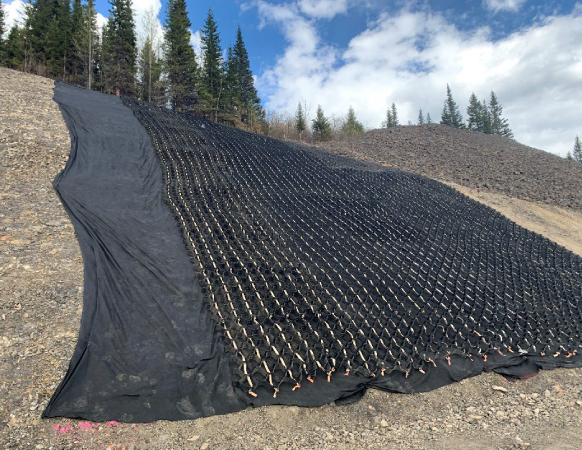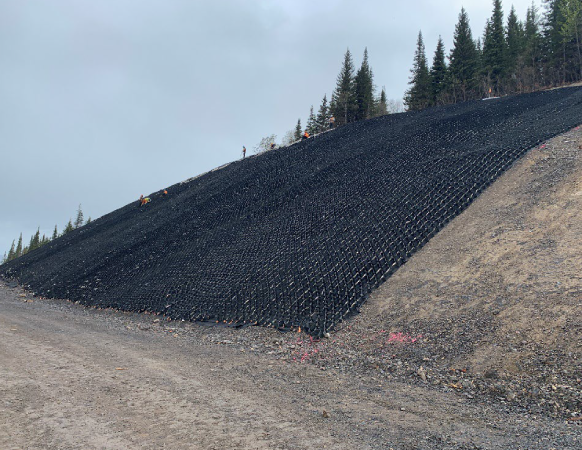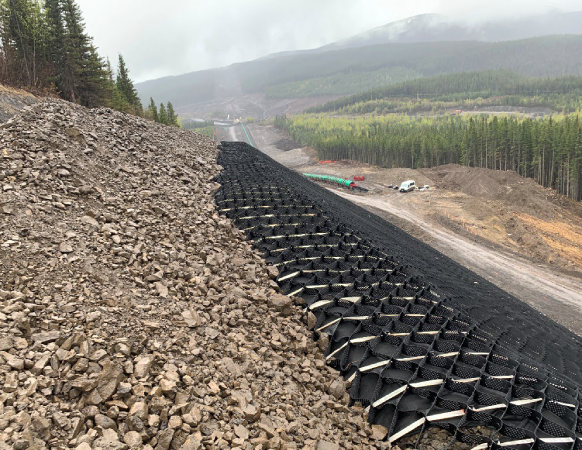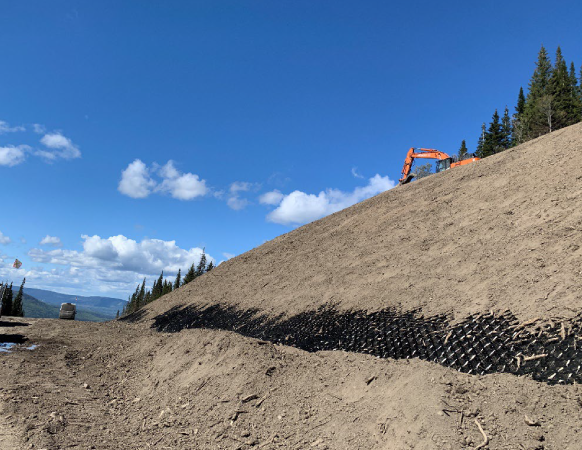The challenge
Nestled in the foothills of the Canadian Rockies, a coal mining community in Tumbler Ridge, British Columbia, was grappling with the challenges posed by the abundance of shale slopes that had formed over time. One particular soft shale slope was degrading due to geomorphic processes, leading to scour and erosion of the hillside. This problematic slope was situated above a mechanically stabilized earth (MSE) wall that supported a new coal conveyor, defying vegetation establishment and jeopardizing the project’s integrity.
The solution
The initial plan, which relied on topsoil and natural vegetation, proved insufficient due to the risks of snow loading and natural erosion. To address these issues, Presto Geosystems’ engineering team completed several project evaluations on the slope, assessing different slope lengths and anchorages to compensate for snow loadings.
These evaluations provided product recommendations tailored to the site’s specific characteristics, structural values, and specifications. Based on the results, the GEOWEB® Geocells with exclusively designed ATRA® geocell accessories were selected as a long-term, cost-effective slope stabilization solution. The GEOWEB System maintains the slope angle while keeping granular material in place.
Collaborating with Presto Geosystems’ design team, Layfield crafted a cross-section profile for the most challenging part of the slope (PR23673). Partnering closely with TetraTech’s engineer of record and Duz Cho Construction, they forged a deployment plan that promised stability and resilience.
Installation
The project installation began by digging a trench for the deadman pipe at the top of the slope. Then, using a man-lift, a non-woven geotextile separation layer was placed along the sidehill cut slope area.
Once the geotextile sections were laid down, the GEOWEB® Geocells were expanded down the 1.43H:1V cut slope, and the tendons were tied to the deadman anchor at the top of the slope. The project evaluation specified using GEOWEB® (GW30V4) mid-sized cells, with 4-inch deep panels. The integral ATRA® Tendon Clips were attached to each tendon at every sixth GEOWEB® cell.
After the GEOWEB® sections were expanded, the contractor backfilled the deadman crest area with on-site siltstone bedrock. They then continued to backfill the GEOWEB® Geocells with topsoil, starting at the slope’s crest and working down towards the toe.
The GEOWEB® sections were slightly overfilled to allow for consolidation and compaction of the backfill as per the specifications, and the area was seeded for vegetation growth.
Conclusion
Layfield’s on-site technical support was pivotal, guiding the contractor through best practices to ensure a safe and successful installation. The deployment was executed swiftly and without incident, thanks to meticulous planning and on-the-fly adjustments. These included pre-assembling the GEOWEB® sections before deployment and realigning the anchor trench for optimal effectiveness and ease of construction.
Through innovation and support, Layfield effectively addressed a challenging task, reinforcing the slope and safeguarding the conveyor line. This project highlights the practical benefits of geosynthetics and the collaborative effort involved.



